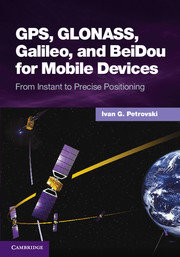Book contents
- Frontmatter
- Contents
- Foreword by Glen Gibbons
- About this book
- Acknowledgments
- List of abbreviations and acronyms
- List of definitions
- Part I GNSS: orbits, signals, and methods
- 1 GNSS ground and space segments
- 2 GPS, GLONASS, Galileo, and BeiDou signals
- 3 Standalone positioning with GNSS
- 4 Referenced positioning with GNSS
- Part II From conventional to software GNSS receivers and back
- Part III Mobile positioning at present and in the future
- Part IV Testing mobile devices
- Index
- References
1 - GNSS ground and space segments
from Part I - GNSS: orbits, signals, and methods
Published online by Cambridge University Press: 05 May 2014
- Frontmatter
- Contents
- Foreword by Glen Gibbons
- About this book
- Acknowledgments
- List of abbreviations and acronyms
- List of definitions
- Part I GNSS: orbits, signals, and methods
- 1 GNSS ground and space segments
- 2 GPS, GLONASS, Galileo, and BeiDou signals
- 3 Standalone positioning with GNSS
- 4 Referenced positioning with GNSS
- Part II From conventional to software GNSS receivers and back
- Part III Mobile positioning at present and in the future
- Part IV Testing mobile devices
- Index
- References
Summary
Global Navigation Satellite Systems (GNSS) at the time of writing comprise four systems, two of which are fully operational and two of which are on their way (see Table 1.1). A brief history of GNSS is given in Chapter 10 along with a timeline of application development and prospects for this development, especially concerning mobile applications.
Each GNSS comprises a constellation of satellites, called a space segment, and a ground segment (Figure 1.1). The main idea behind GNSS is to measure distances between a satellite and a user located on the surface of the Earth or in a lower atmosphere. Satellite coordinates can be calculated at any moment of time. The information that allows the calculation of satellite position is uploaded to and then broadcast from satellites to the user. The ground segment is responsible for determining satellite orbits, which it then uploads to the satellites, and also for defining the coordinate frame and time frame in which satellite and user positions are estimated.
Having received the information on satellite orbits and measured distances to the satellites, a user can calculate receiver position as an intersection of four spheres in a four-dimensional space-time continuum. If the receiver clock is perfectly synchronized with the satellite time frame, only three satellites would be required to determine receiver position in three-dimensional space (Figure 1.2).
- Type
- Chapter
- Information
- GPS, GLONASS, Galileo, and BeiDou for Mobile DevicesFrom Instant to Precise Positioning, pp. 3 - 38Publisher: Cambridge University PressPrint publication year: 2014



